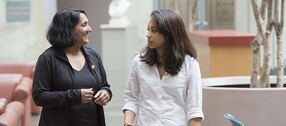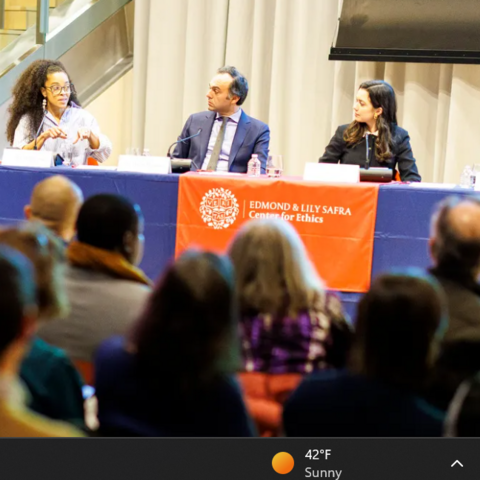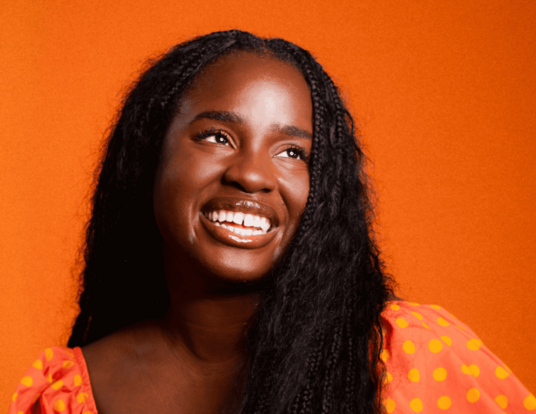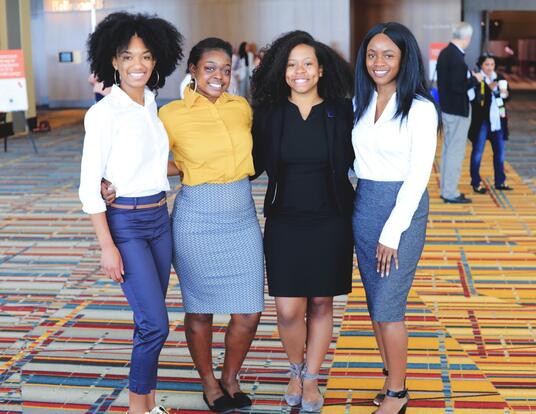Access to Academia
How GSAS programs help level the playing field in graduate studies, academia, and beyond

ZIP codes do more than define a mail delivery area. They are also powerful indicators of privilege. Depending on your ZIP code, your education may have included programs designed to give you a better academic start in life—or not. “Many of us have had opportunities we may not recognize that gave us access to a quality education from day one,” says Sheila Thomas, assistant dean for diversity and minority affairs at Harvard’s Graduate School of Arts and Science and an assistant professor of medicine at Harvard Medical School. “Some people start from behind, no matter how capable and smart they are.” In certain instances that means that individuals living in poorer areas—many of them minorities—look far less competitive in their quest for undergraduate and graduate success, and often attend colleges that are less familiar to faculty based in the Ivy League. And that ultimately affects who is seen as competitive in the search for a career in academia.
Thomas heads up GSAS’s Office of Diversity and Minority Affairs, working with Stephanie Parsons, the assistant director of diversity and minority affairs, to cultivate an environment of inclusivity by recruiting and mentoring a community of scholars that reflects the ethnic and cultural diversity of society. The office also runs several programs that enable undergraduates from minorities underrepresented in graduate study and academia to gain research experience and build fruitful connections with Harvard professors. These programs also expand the perspectives of faculty who may not have recognized the students’ home institutions but who now have a greater awareness for the talent that can be found at schools less familiar to them.
The Summer Honors Undergraduate Research Program (SHURP) is a ten-week summer internship primarily for college students belonging to groups that are underrepresented in the sciences. Since its establishment by Jocelyn Spragg in the 1990s, nearly 500 students from colleges across the country have participated, with more than 90 percent going on to further education and careers in the sciences. SHURP places students in Harvard professors’ labs, where they often work with graduate student or postdoc mentors on research projects. Another initiative established by Harvard’s Office of the Provost in 2003, Summer Research Opportunities at Harvard (SROH), connects talented undergraduates from across the country who are considering pursuing a PhD in the humanities, social sciences, or the sciences with Harvard mentors. Both programs, while focused on improving students’ research abilities, provide targeted training in presentation skills and career development. GSAS recently launched a post-baccalaureate program designed to help college graduates improve their research resumes in advance of applying to graduate schools. Those who participate in all three of these programs may have come believing that they would not be competitive—or welcome—at Harvard, but they leave knowing that they are capable of success here and at comparable institutions. In the process, Harvard’s faculty learns that the best students may come from institutions they aren't accustomed to.
A Unique Point of View
Rosio Fernandez thinks viruses are like teenagers. “It intrigues me that people always look at viruses as though they are a negative thing,” she says. “Yes, they have their negative points but so do teenagers. Many things in life have a good and a bad side, but we always focus on the bad with viruses.” Fernandez believes that, like teenagers, a virus’s behavior can be changed—with the right motivation. “Viruses can be used for good, for example in the medical field to transfer material into a body.”
As a kid growing up in Manhattan’s Washington Heights, the daughter of Dominican immigrants, Fernandez wasn’t thinking about viruses. “I was determined to study painting and design,” she says. “I first thought I wanted to be a fashion designer.” Fernandez always looked at things from a different perspective than many people she knew. As she moved from high school to Brooklyn College, she began to wonder whether her unique way of looking at the world would be better served in a medical career. And that’s when she really found her passion for science.
“As I became involved in research, I began reading more about viruses,” Fernandez says. “I wanted to know how viruses interact with cells in order to have a positive effect. What are the mechanisms that drive that process?” She wanted to understand how research could address medical disorders, such as Ehlers-Danlos syndrome, which affected a friend’s ability to produce collagen in her body. “I thought, wouldn’t it be cool if we had a virus that could transport a mutation to provide a more functional protein for collagen in every cell of your body?” she says. “Because that’s what viruses can do. They can infect almost every cell in your body.”
It was another friend who introduced Fernandez to Harvard’s SHURP program. “My friend participated in the program after her sophomore year and told me it was the best experience,” she says. “Her mentor recommended that I apply.” Based in the lab of HMS professor Donald Coen, Fernandez investigated how viruses exit the nucleus, guided by her mentor Mayuri Sharma. “The best part of SHURP is being in the lab and I am very fortunate to work with a mentor who pushes me, who gets me to think more about the process,” Fernandez says. “I feel like she is helping me to become a better scientist.” She intends to head back to Brooklyn College energized to develop her own projects with her professors. She also plans to apply to graduate schools and continue enhancing her research experience. “My career plans have definitely shifted from fashion designer to virologist,” she laughs, but notes that there are similarities. “As a fashion designer, you have to be creative and think of new ideas all the time. It’s the same in science, except now I’m using my creativity to develop the perfect virus and cure disease.”
Broadened Horizons
In 1964, President Lyndon Johnson traveled to Martin County, Kentucky, to launch the War on Poverty, and the location soon became synonymous with poverty. By the time Seth Henderson was growing up 100 miles away in Harlan County, Kentucky, not much had changed. “Harlan has a lot of poverty and very little opportunity to grow mentally and expand one’s view of the great diversity of this nation, which is very important to me,” Henderson says. “My early education was one of very little diversity and few opportunities to see the world beyond the mountains of Harlan.”
Despite these barriers, Henderson persevered and went on to study criminal justice at Eastern Kentucky University. After his sophomore year, he served as an intern in his local Congressman’s office; he enjoyed the experience so much that he decided to double major in criminal justice and political science. Looking to find a summer research opportunity in 2013, he stumbled across the SROH program. Henderson was thrilled at the chance to gain experience that would prepare him for graduate-level work.
SROH partnered Henderson with Jennifer Hochschild, the Henry LaBarre Jayne Professor of Government and Professor of African and African American Studies in the Department of Government. Together, they conducted research at the intersection of American politics and political philosophy in the areas of race, ethnicity, and immigration around DNA collection in the judicial system. For Henderson, this experience transformed his educational experience and opened doors that might have remained closed to him.
“The SROH program allowed me to broaden my horizons and instill in me a deeper belief that my destiny will go beyond Kentucky,” he shares. “I was able to network with professors and other professionals, which has helped me in other career endeavors.” While at Harvard, Henderson decided he wanted to become a White House intern and he credits his success with that goal to Hochschild’s mentorship. “I likely would never have thought that I could become an intern at the White House if SROH had not helped me realize my potential,” he says.
Feeling Represented
As a ten-year-old growing up in Colombia, Carolina Salguero knew she wanted to study chemistry. “My father read the paper at the breakfast table every morning, and he would pass sections on to me,” she remembers. “I saw an article about the sequencing of the human genome and thought it was the most interesting thing I’d heard in my life.” The idea of participating in the genome project energized Salguero to learn as much science as she could, in the process discovering the important role chemistry plays in the field. “I realized that everything in life has chemistry in it,” she says, “so I knew that whatever I wanted to do, I would need to learn chemistry first.”
Following her sister to the United States, Salguero eventually became a scholar of the Maximizing Access to Research Career (MARC) program at Hunter College, from which she earned a degree in biochemistry and economics in 2011. It was while she was a MARC scholar that she learned about SROH. While attending the Annual Biomedical Research Conference for Minority Students (ABRCMS), she met Victoria D’Souza, an associate professor of molecular and cellular biology at Harvard. “After I heard Victoria’s research talk, I knew that I wanted to work with her, so I approached her and asked if she would give me a chance to intern in her lab.” D’Souza told her about a summer internship program in molecular and cellular biology that was a precursor to SROH and encouraged her to apply.
“I was one of the first to come to Harvard under the SROH program,” Salguero says. “The results I obtained that summer allowed me to gain authorship of an article published in Nature, which was a huge achievement for me.” She also developed a strong mentoring relationship with D’Souza that lasted beyond the summer. “Victoria continued to mentor me and helped me through the graduate application process. When I was accepted to GSAS, she encouraged me to come to Harvard and work in her lab.”
But it wasn’t just D’Souza’s counsel that helped Salguero envision herself as a researcher. “Not only was she a terrific mentor, but she is a very successful woman scientist, who is also from an underrepresented background,” she explains. “I felt that she understood where I was coming from and that’s something important for me and for most students like me; we want to feel that we belong wherever we go.”
Enthusiasm for Science
Jason Sello, PhD ’02, always knew what he wanted to be when he grew up. “When I was in high school, I decided that I wanted to be a professor in part because I read a career guide that said professors had among the highest rates of job satisfaction,” he remembers. “So, I said well, being satisfied with your job seems to be pretty important, that seems like a good thing.”
Sello studied at Morehouse College with this specific aim in mind, ultimately deciding to major in biology. “I had conversations with some of the faculty, asking what it takes to become a professor,” he remembers. “And they said, well, you’ve got to get started with research.” However, since Morehouse’s primary mission is teaching, Sello didn’t have access to the intense research activity that takes place at larger institutions. He did, however, find a mentor determined to help him succeed.
“I started my research career with a member of the faculty named Joseph McCray, a Morehouse alumnus who earned his PhD at Purdue,” says Sello. “Interestingly, Dr. McCray’s ultimate goal was to populate research universities with African American scientists via training and mentoring students at Morehouse.” Sello worked with McCray during his entire time at Morehouse. He was also encouraged to seek out opportunities at research universities during the summers that would bolster his research experience. His first experience away from Morehouse was at Purdue during the summer between his sophomore and junior years. There, he worked in a laboratory that was using methods from structural biology to understand how viruses are neutralized by antibodies.
In addition to research, McCray encouraged Sello to attend scientific conferences that would expand his horizons. In one instance, Sello flew to New York City for a conference at the Rockefeller University that brought together world-class scientists to commemorate the death of Louis Pasteur. It was there that he had an auspicious encounter with Stuart Schreiber, the Morris Loeb Professor of Chemistry and Chemical Biology, who strongly encouraged him to consider graduate study at Harvard.
The next year, in an effort to gain more research experience in structural biology, he reached out to James Hogle, the Edward S. Harkness Professor of Biological Chemistry and Molecular Pharmacology at Harvard. “Jim is one of the world’s experts on the structures of viruses, which I had studied at Morehouse and Purdue,” Sello says. Hogle connected him with Jocelyn Spragg, who ran SHURP.
“SHURP, from my perspective, is a great talent identification program,” Sello says. “It’s really an opportunity for Harvard to demonstrate how welcoming and open it can be to students who are underrepresented in the academy.” When it came time to apply to graduate schools, Sello remembered his experience working in the Hogle lab and his conversation with Schreiber. “Part of the reason that I was attracted to Harvard was because my interactions with faculty had been so positive,” he says. He was admitted to the graduate program in biophysics and ultimately pursued doctoral work with Schreiber. During his graduate studies, Sello became very interested in the origins, structures, and biological activities of natural products—small molecules that are used by organisms for chemical defense and often have utility in medicine. This interest led him to postdoctoral research in biochemistry at Harvard Medical School with Professor Christopher Walsh and in bacterial genetics at the John Innes Centre in Norwich, England.
After his postdoctoral work, Sello joined the chemistry faculty at Brown University in 2006, earning tenure in 2012. He and members of his research group are working on drug discovery, antimicrobial resistance, natural product biosynthesis, and bioenergy. “There’s no question that my experiences as an undergraduate and graduate student at Harvard helped prepare me for the tenure-track,” he says. “Many of the students who participate in programs like SHURP are incredibly talented, highly motivated, and I think it’s important for Harvard to tap into that energy and enthusiasm.”
That enthusiasm, Sello believes, helps a student from any background get on track for academia. “I often tell the undergraduates and graduate students, never let anyone compromise your enthusiasm for science because once that’s gone, then a career in science is nearly untenable.”
A Competitive Edge
The most powerful experience for students participating in SHURP, SROH, and the new post-baccalaureate program is the opportunity to understand and partake in the work conducted at a research university and to interact directly with Harvard faculty—whose own perspectives are changed by the experience. Students leave with experience to add to their resumes and recommendations from Harvard professors—they leave more competitive, more likely to be accepted to graduate programs, more likely to earn their PhDs, and more likely to join academia and succeed on the tenure track.
And that is the ultimate aim of these programs: to encourage minorities traditionally underrepresented in the academy to seek an academic career. “The United States is a diverse country, but that diversity is not always represented in the academy,” Thomas says. “These programs are important if you want diversity of experience reflected in the research that comes out of institutions of higher learning—breakthroughs that influence technology and policy.” But it isn’t just about what happens within the academy: it’s also about addressing the ZIP code problem. “At GSAS, we are doing what we can to provide students that are clearly smart, intelligent, and driven the resources they need to come to Harvard in pursuit of their goals.”
Illustration by Dante Terzigni
Get the Latest Updates
Join Our Newsletter
Subscribe to Colloquy Podcast
Simplecast





